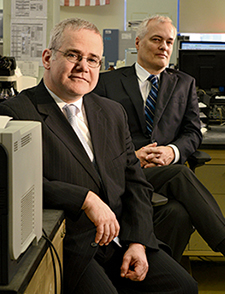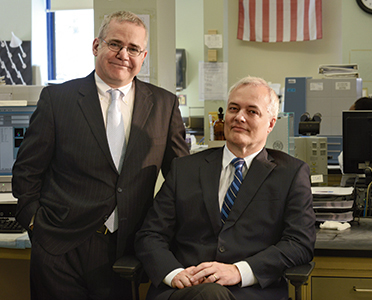Anne Paxton
February 2014—For “quants”—people who love all things numeric or algorithmic—information technology is its own reason for being. But for those with responsibility for clinical outcomes and the bottom line in the clinical laboratory, IT is much, much more.

Alexander Kratz, MD, PhD (left) and
Jorge Sepulveda, MD
Innovative uses of IT are providing myriad new solutions with measurable paybacks in quality improvement and cost reduction. In a panel on using IT to achieve clinical and financial goals of the hospital laboratory, several presenters at the July 2013 meeting of the American Association for Clinical Chemistry described how their institutions are employing order-entry research, decision rules, and quality metrics with desktop software, open-source data analytic tools, and middleware to make quantifiable improvements in their processes and results.
The move from paper requisitions and paper laboratory reports to electronic systems, which continues apace under federal incentives, has major advantages for laboratories, said panel moderator and presenter Alexander Kratz, MD, PhD, medical director of the core laboratory at New York-Presbyterian Hospital, Columbia University Medical Center.
Between 2009 and 2011, the proportion of U.S. physicians who reported that they are using the basic electronic medical record increased from 22 percent to 34 percent, Dr. Kratz noted, while in primary care the percentage almost doubled. Why should pathologists be very interested in the EMR? “Because you can actually get certain things done that you as the laboratory want to achieve,” Dr. Kratz said. He discussed how laboratories can improve service to consumers by using IT to adapt orders, analysis, and result reporting.
Electronic order screens, for instance, should not be simply digitized lists of what appeared on old paper requisitions; they should be thoughtfully built. Dr. Kratz showed the routine order screen used until recently in his institution each day to draw morning labs for 1,000 patients. “The setup of the order screen was that the CBC differential was in the first section, for routine labs, and the CBC with auto differential was under hematology.”
At his hospital, however, manual differentials are problematic, because the hospital lacks enough technologists with the appropriate skills. “We were trying to reduce the number of manual differentials, and we are looking at this order screen and we’re saying ‘this is not right.’ Whoever designed this didn’t really think through the effects on the laboratory, because the CBC with differential was up top as a routine lab.”
So the laboratory switched the “CBC with DIF” down and moved the CBC with auto differential up to the top. The results were immediate and striking. “Other than the IT people, we didn’t tell anybody. And essentially the CBCs went up by approximately 1,000 a month and the CBCs with DIF went down by about 1,000 a month,” Dr. Kratz said. “And now it is almost two years later and, so far, nobody has complained or said ‘I ordered the wrong tests and something happened’ or ‘there was a negative outcome.’
“So just by changing the order screen, you can actually influence physician ordering behavior and perhaps make your laboratory more efficient because you can concentrate on those tests you actually want to do.”

Dr. Alexander Kratz (left) and Dr. Jorge Sepulveda at New York-Presbyterian Hospital, where the electronic medical record system and common desktop software are being used to make the operation of the laboratories more efficient.
A study conducted in Israel (Shalev V, et al. Int J Med Inform. 2009; 78:639–644) reported similar results. A preferred provider organization with 865 primary care physicians used an order screen that required them to type in manually any test that was not listed in check-box form. “The pathologists went and changed the order screen by removing some tests and adding some others,” reducing the number of tests that could be ordered by check-box by 27 and adding two, Dr. Kratz said. “They found that one year later, the tests that had been added had increased in use by 60 percent. In two more years, an additional 90 percent increase was observed.”
“On the other hand, those tests that they removed went down the first year by 27 percent and by an additional 19.2 percent the second year,” Dr. Kratz said. “So they clearly saw the same effect we did: namely, if you change the facility or the ease with which the physician can order the test, they will be more likely or less likely to use it.”
Dr. Kratz encourages pathologists to be involved in the design and maintenance of their institutions’ computerized order-entry and EMR systems. At his five-campus hospital system, a committee called CHEMISTRY (Clinical Harmonization of the Electronic Health Record and Management of Intervention Solutions) is responsible. “Adding orders, changing the way results are documented, clinical decision support, assuring regulatory compliance, alerts—everything goes through this committee.” And the laboratory makes sure it is an integral part of the process.
As another way to discourage clinicians from ordering lab tests and blood products that are not indicated, the laboratory has created special alerts. “We added a required field into the order screen for red blood cells and they have to choose an indication for the order. And if I choose, for example, the indication of ‘hemoglobin less than 8 g/dL,’ the system might very nicely point out that the last hemoglobin for this patient happens to be 12.5; please use a different indication.” Adding links to required online consent forms—for example, for HIV or amino acid tests—is an additional way to make the clinician’s life easier, “and therefore your life easier,” Dr. Kratz said.
He also advocated including detailed cancelation messages on the EMR when a test has to be canceled. “‘Canceled by performing department’ means that the mean and unfair laboratory, instead of doing the test, is canceling it, not really leading to patient satisfaction,” Dr. Kratz said. “So we are now putting a specific message as far as possible, such as ‘quantity not sufficient’ or ‘specimen not received’ or ‘canceled—pneumatic tube delivery delay.’ And the clinician can see that on the results screen.”
The hospital system’s IT department has helped the laboratory by including orders for point-of-care assays in the EMR. “When the clinician checks off an order for a point-of-care glucose or HIV test, the nurse knows what needs to be done and that the regulatory documentation is there. Then the nurse will do the point-of-care test and result it into a flow sheet, where he or she also has to check off that the onboard QC was passed.” That includes lines for the lot number and expiration date of the kit. “So when the Joint Commission or CAP comes to inspect you and they do a tracer on a point-of-care test and ask, ‘How do you know the nurse actually did the QC?’ you can say ‘You see? There it is.’”
 CAP TODAY Pathology/Laboratory Medicine/Laboratory Management
CAP TODAY Pathology/Laboratory Medicine/Laboratory Management
